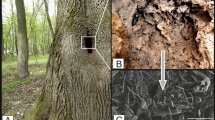Abstract—
The effect of chitosan (200 kD, 75% deacetylation) on Nosema apis development in bee colonies during wintering was investigated. The conditions for development of the nosematous infection were analyzed. According to the results of determination of PCR products specific for N. apis, chitosan decreased significantly the degree of infection of individual bees with N. apis spores. The scheme of stimulation of the bee immune system by chitosan via the changes in the level of antimicrobial peptides and proteins of the macroorganism antioxidant systems is discussed. Due to a decrease in the degree of infection with N. apis, survival of the bees increased during the long winter period.




Similar content being viewed by others
REFERENCES
Alaux, C., Brunet, J.-L., Dussaubat, C., Mondet, F., Tchamitchan, S., Cousin, M., Brillard, J., Baldy, A., Belzunces, L.P., and LeConte, Y., Interactions between Nosema microspores and a neonicotinoid weaken honeybees (Apis mellifera), Environ. Microbiol., 2010, vol. 12, pp. 774‒782.
Amdam, G.V., Simoes, Z.L.P., Hagen, A., Norberg, K., Schrader, K., Mikkelsen, O., Kirkwood, T.B.L., and Omholt, S.W., Hormonal control of the yolk precursor vitellogenin regulates immune function and longevity in honeybees, Exp. Gerontol., 2004, vol. 39, pp. 767‒773.
Antunez, K., Martin-Hernandez, R., Prieto, L., Meana, A., Zunino, P., and Higes, M., Immune suppression in the honey bee (Apis mellifera) following infection by Nosema ceranae (Microsporidia), Environ. Microbiol., 2009, vol. 11, pp. 2284‒2290.
Chevari, S., Chaba, I, and Sekei, I., Role of superoxide dismutase in cellular oxidative processes and the method for its determination in biological materials, Lab. Delo, 1985, no. 11, pp. 678‒681.
Dussaubat, C., Brunet, J.L., Hige, M., Colbourne, J.K., Lope, J., Jeong-Hyeon, C., Martin-Hernandez, R., Botias, C., Cousin, M., McDonnell, C., Bonnet, M., Belzunces, L.P., Moritz, R.F.A., Le Conte, Y., and Alaux, C., Gut pathology and responses to the microsporidium Nosema ceranae in the honey bee Apis mellifera, PLoS One, 2012, vol. 7. e37017.
Evans, J.D. and Lopes, D.L., Bacterial probiotics induce an immune response in the honey bee (Hymenoptera: Apidae), J. Econ. Entomol., 2004, vol. 97, pp. 752‒756.
Gaifullina, L.R., Saltykova, E.S., and Nikolenko, A.G., Structure and mechanisms of humoral immunity in insects, Usp. Sovr. Biol., 2006, vol. 126, no. 6, pp. 617‒629.
Glupov, V.V., Slepneva, I.A., and Dubovskii, I.M, Generation of activated oxygen metabolites during formation of immune response in insects, Trudy Zool. Inst. RAN, 2009, vol. 313, no. 3. 297‒307.
Gregory, P.G., Evans, J.D., Rinderer, T., and De Guzman, L., Conditional immune-gene suppression of honeybees parasitized by Varroa mites, J. Insect Sci., 2005, vol. 5, no. 3, pp. 1‒5.
Havukainen, H., Munch, D., Baumann, A., Zhong, S., Halskau, O., Krogsgaard, M., and Amdam, G.V., Vitellogenin recognizes cell damage through membrane binding and shields living cells from reactive oxygen species, J. Biol. Chem., 2013, vol. 288, pp. 28369‒28381.
Huang, Q., Kryger, P., Le Conte, Y., and Moritz, R.F.A., Survival and immune response of drones of a Nosemosis tolerant honey bee strain towards N. ceranae infections, J. Invertebr. Pathol., 2012, vol. 109, pp. 297‒302.
Korolyuk, M.A., Ivanova, L.I., Maiorova, I.G., and Tokarev, V.E., Method for determination of catalase activity, Lab. Delo, 1988, no. 1, pp. 16‒19.
Koywiwattrakul, P., Thompson, G.J., Sittipraneed, S., Oldroyd, B.P., and Maleszka, R., Effects of carbon dioxide narcosis on ovary activation and gene expression in worker honeybees, Apis mellifera, J. Insect Sci., 2005, vol. 5, no. 5. pp. 36‒45.
Martin-Hernandez, R., Meana, A., Prieto, L., Salvador, A.M., Garrido-Bailon, E., and Higes, M., Outcome of colonization of Apis mellifera by Nosema ceranae, Appl. Environ. Microbiol., 2007, vol. 73, pp. 6331‒6338.
Mayack, C. and Naug, D., Parasitic infection leads to decline in hemolymph sugar levels in honeybee foragers, J. Insect Physiol., 2010, vol. 56, pp. 1572‒1575.
Rahnamaeian, M., Cytrynska, M., Zdybicka-Barabas, A., Dobslaff, K., Wiesner, J., Twyman, R.M., Zuchner, T., Sadd, B.M, Regoes, R.R., Schmid-Hempel, P., and Vilcinskas, A., Insect antimicrobial peptides show potentiating functional interactions against Gram-negative bacteria, Proc. Royal Soc. B., 2015, vol. 282, pp. 20150293.
Rauschenbach, I, Yu., Stress response in insects: mechanism, genetic control, and role in adaptation, Russ. J. Genet., 1997, vol. 33, no. 8, pp. 942‒949.
Salmela, H., Amdam, G.V., and Freitak, D., Transfer of immunity from mother to offspring is mediated via egg-yolk protein vitellogenin, PLoS Pathogens, 2015, vol. 11, no. 7. e1005015.
Saltykova, E.S., Benkovskaya, G.V., Gaifullina, L.R., Novitskaya, O.P., Poskryakov, A.V., and Nikolenko, A.G., Reaction of individual physiological barriers in bacterial infection in different races of the honeybee, Apis mellifera, J. Evol. Biochem. Physiol., 2005, vol. 41, pp. 318‒324.
Saltykova, E.S., Karimova, A.A., Gataullin, A.R., Gaifullina, L.R., Matniyazov, R.T., Frolova, M.A., Albulov, A.I., and Nikolenko, A.G., The effect of high-molecular weight chitosans on the antioxidant and immune systems of the honeybee, Appl. Biochem. Microbiol., 2016, vol. 52, pp. 553‒557.
Scopes, R.K., Protein Purification: Princioles and Practice, New York: Springer, 1982.
Seehuus, S.C., Norberg, K., Gimsa, U., Krekling, T., and Amdam, G.V., Reproductive protein protects functionally sterile honey bee workers from oxidative stress, Proc. Natl. Acad. Sci. U. S. A., 2006, vol. 103, pp. 962‒967.
Serdyuchenko, I.V., Microbiocenosis of honeybee intestinal tract and its correction, Extended Abstract Cand. Sci. (Biol.) Dissertation, Krasnodar: Kuban State Agr. Univ., 2003.
Zhang, S., Wang, S., Li, H., and Li, L., Vitellogenin, a multivalent sensor and an antimicrobial effector, Int. J. Biochem. Cell Biol. 2011, vol. 43, pp. 303‒305.
ACKNOWLEDGMENTS
The work was supported by the State Assignment (state registration no. AAAA-A16-116020350026-0) using the equipment of the Biomika Collective Use Center, Agidel’ Department of Biochemical Research and Nanobiotechnology.
Author information
Authors and Affiliations
Corresponding author
Additional information
Translated by P. Sigalevichw
Rights and permissions
About this article
Cite this article
Saltykova, E.S., Gaifullina, L.R., Kaskinova, M.D. et al. Effect of Chitosan on Development of Nosema apis Microsporidia in Honey Bees. Microbiology 87, 738–743 (2018). https://doi.org/10.1134/S0026261718050144
Received:
Published:
Issue Date:
DOI: https://doi.org/10.1134/S0026261718050144




